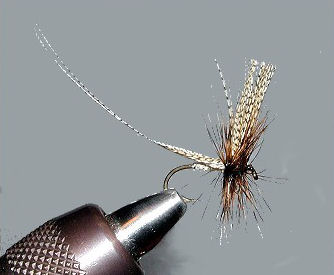
On The Fly
"Fly tying is a school from which we never graduate"
TYING NEWS
The Southern Oregon Fly Tyers invite you to attend their next meeting, Tuesday, May 11,
2010, at 6:30 PM, at the Madrone Hill Mobile Home Park community building near Gold Hill. Bring a
friend, come early so you don't miss anything, and stay late. Tiers need not be experienced, and those with
all levels of skill are welcome. Each meeting a member is encouraged to demonstrate a new or different
skill, from simple to difficult. For more information, call Dan Kellogg at 773-4724.
Ed Morphis was our demonstration tyer for April and he showed us an easy way to tie this
old standard. The H & L Variant is a great fast water fly. Thanks, Ed, for showing us this great little
fly, and for putting aside your own personal discomfort to be at the meeting. I'll be adding this pattern
to my fly box in several different sizes and colors.
The May meeting will be a special night at SOFT. There won't be a tie-along session at
this meeting. May 11 will be an Expo night with several tyers demonstrating different styles of fly tying
all at the same time. Move around whenever you want to. A good night to bring a friend.
DIRECTIONS: Take Gold Hill Exit #40, off of I-5 and go west, toward Jacksonville, 1.3
miles, until you reach the brick entrance way to the Madrone Hill Mobile Home Park on the right. You’ll
pass a golf course parking lot on Your left shortly after leaving the freeway. After you turn right into the
mobile home park, proceed to the community building which is located about 100 yards ahead on the left. The
address is 8401 Old Stage Rd. Please park your vehicle on the bare dirt in the parking lot to avoid the
wooden septic covers in the grass.
PATTERN OF THE MONTH - Two Feathers Fly

Hook: Daiichi 1170, standard dry fly, 12-24
Thread: Your choice, 8-0
Tail, body, wing: Mallard breast feather
Hackle: Your choice
Tying Instructions
Step 1: Mash the barb and mount the hook in the vise. Start the tying thread one eye width behind the eye
and wrap a thread base back to a point halfway down the shank.
Step 2: Feather preparation. Select a symmetrical Mallard flank or body feather with a natural curve up.
Cut the stem at the tip if the feather forming a “V”. Trim the stem of feather to just slightly longer than
the desired length of the extended body (about one shank length).
Step 3: Now take the prepared feather, stroke the fibers down on each side towards the base of the stem.
Then take a bodkin and separate two fibers from the rest on each side of the stem at the tip to form a tail
of the extended body.
Step 4: Pull the remaining fibers tightly towards the base of the stem and with the concave side up, tie
in where the thread is hanging on top of the hook shank.
Step 5: After the extended body is secured, stand up the excess Mallard fibers with additional thread wraps
in front to form the wings of the fly.
Step 6: Tie in and wrap the dry fly hackle, 3wraps behind and 3 in front of the wing. Tie off and trim.
Form a small neat head, whip finish, and cement.
Step 7: Trim the wing to length. Should be just slightly longer than the hackle
I just returned from a mini conclave in Reedsport, OR and saw a tier from Roseburg doing
his version of an old extended body mayfly pattern. The Two Feather Fly was developed in the Catskills by
Harry Darbee in the 1950’s when asked by Terrell Moore to make him a dry fly pattern that weighed no more
than a natural mayfly. His “Darbees” as they became known, were a unique method of fly tying using only one
feather for the tail, body and wing, and another for the hackle. The fly was meant for smooth, glass-like
water, on rivers and streams. The pattern can easily be scaled from imitating large hex down to the tiniest
BWO’s. Most extended body flies are quite complicated requiring they be built on a separate needle before
tying to the hook. This one is simple enough for any level tyer.
TYING TIPS
On smaller sizes try a curved grouse breast feather for tail, body, and wing. Simply vary
the feather colors and size propotions for the different hatches. For more buoyancy on swifter waters use
more turns of hackle. So tie some up, give them a test flight and let me know how you did.
Tie One On,
Dan Kellogg (you can contact me at FLYGUY@EZNORTHWEST.COM)